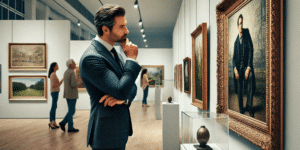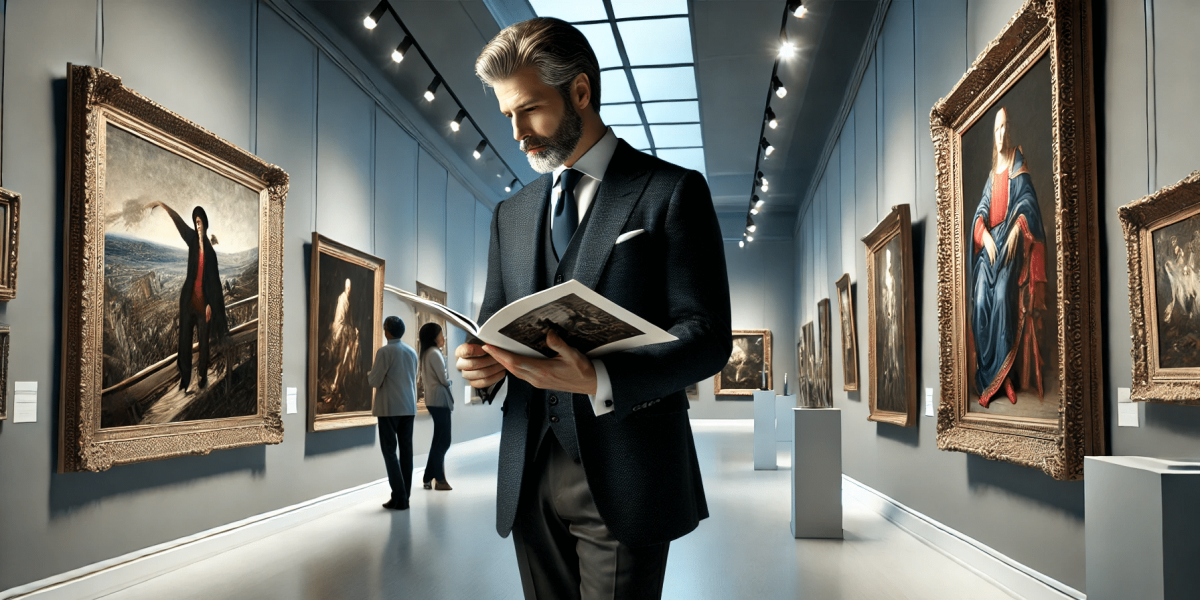In the realm of art collecting, what was once a pursuit driven by passion and a desire for prestige has evolved into a recognized asset class. This introduction delves into the economic forces that exert influence on the art market, causing a shift in focus from solely aesthetic considerations to financial ones. We will explore the various factors that impact the value of artworks, including their historical significance, artistic merit, and prevailing market trends.
Furthermore, we will examine the role that different stakeholders, such as collectors, auction houses, and galleries, play in shaping the dynamics of the art market. By gaining an understanding of these economic forces, collectors can make well-informed decisions and navigate the art market strategically.
The Cascading Effect of Art Collecting
Art collecting transcends the realm of personal passion. It orchestrates a complex economic symphony, impacting the global economy, artists, galleries, and of course, the collectors themselves.
Influence on Global Economy:
Art hubs, like London or New York, thrive on the art market. High-value transactions generate tax revenue for governments. Additionally, art fairs and auctions attract international visitors, boosting tourism and hospitality sectors. Museums, funded by collectors and philanthropists, become cultural magnets, drawing in tourists and further stimulating local economies.
Financial Benefits for Collectors:
Art can be a hedge against inflation. Unlike stocks or bonds, artworks can appreciate significantly in value over time, particularly pieces by established or emerging artists. However, the art market is complex, and not all investments are guaranteed successes. Expertise and a long-term perspective are crucial for collectors aiming for financial gains.
Financial Benefits for Artists:
A thriving art market provides a vital source of income for artists. Sales through galleries, auctions, or directly to collectors allow artists to sustain their careers and reinvest in their craft. Recognition from prominent collectors can also propel an artist’s reputation and lead to increased demand for their work.
Financial Benefits for Galleries:
Galleries act as intermediaries between artists and collectors, facilitating sales and earning commissions on transactions. They also play a crucial role in promoting artists, organizing exhibitions, and fostering a vibrant artistic community. A strong art market allows galleries to expand their programming, invest in new talent, and contribute to the cultural landscape.
Art collecting is more than just acquiring beautiful objects. It’s a powerful economic force that fuels the global art industry, generates revenue for governments, and provides financial benefits for a range of stakeholders.
The Art of Art Valuation: The Price Tag
The value of a piece of art goes beyond the cost of materials and the time it takes to create. It’s a complex equation influenced by historical significance, artistic merit, and the ever-evolving art market. Let’s delve into the factors that contribute to art valuation and the methods used to determine a price tag.
Factors Contributing to Valuation:
- Artist Reputation: Established artists with a proven track record of successful exhibitions and sales typically command higher prices. Awards, critical acclaim, and recognition by major museums further solidify an artist’s reputation and value.
- Provenance: The documented history of ownership can significantly impact value. A piece that belonged to a renowned collector or has been exhibited in prestigious institutions becomes more desirable.
- Trends: Art movements and prevailing tastes influence prices. Pieces that align with current trends are likely to fetch higher prices compared to those that are out of favor.
- Rarity: Limited-edition prints or sculptures by renowned artists are more valuable than mass-produced works. The fewer pieces available, the higher the potential price.
- Condition: The physical state of the artwork is crucial. A well-preserved piece with minimal damage or restoration will be valued more highly than a work that has deteriorated.
Methods of Valuation:
- Appraisals: Qualified art appraisers analyze the artwork’s characteristics, research market data on similar pieces, and consider the factors mentioned above to arrive at a fair market value.
- Market Comparables: This method involves comparing the artwork to similar pieces recently sold at auctions or through galleries. This provides a benchmark for determining a realistic price.
- Auction Results: Auction results for works by the same artist or from similar periods offer valuable insights into current market trends and can be used as a guide for valuation.
It’s important to note that art valuation is not an exact science. Expert opinions, market fluctuations, and even a buyer’s emotional connection to the piece can influence the final price.
The Art of Building an Art Collection: Strategies for Success
Art collecting, while driven by passion, can also be a rewarding investment strategy. But navigating the art market requires knowledge and a well-defined approach. Here, we explore key strategies for both novice and seasoned collectors to build a valuable and diverse art collection.
Starting an Art Collection:
- Research and Education: Immerse yourself in the art world. Visit museums, attend gallery openings, and educate yourself on different artistic styles and movements. Familiarize yourself with renowned artists and emerging talents. Resources like art publications, online databases, and consultations with art professionals can be invaluable.
- Budgeting: Set a realistic budget for your art collection. Remember, collecting is a long-term endeavor. Factor in not just the purchase price but also potential framing, insurance, and storage costs.
Building a Diverse Collection:
- Develop Your Taste: Don’t chase trends solely for investment purposes. Instead, focus on acquiring pieces that resonate with you emotionally and aesthetically. Your collection should reflect your personal taste and vision.
- Diversify by Medium and Style: Don’t limit yourself to a single artist, period, or medium. Explore paintings, sculptures, photography, or even installations. A diverse collection mitigates risk and offers a wider range of potential investment opportunities.
- Seek Quality Over Quantity: It’s better to own a few high-quality pieces by promising artists than a large collection of mediocre works. Prioritize authenticity and provenance whenever possible.
Long-Term Investment Strategies:
- Buy and Hold: Unlike stocks that can be traded frequently, art is a long-term investment. Patience is key. Allow the value of your collection to appreciate over time.
- Build Relationships: Cultivate relationships with reputable galleries, dealers, and appraisers. Their expertise can guide your acquisitions and ensure the authenticity of pieces you purchase.
- Stay Informed: Keep abreast of market trends and emerging artists. Attend art fairs, auctions, and talks to stay current on the ever-evolving art world.
Successful art collecting is a journey of discovery and informed decision-making. By combining passion, knowledge, and strategic planning, you can build a collection that is both personally enriching and potentially lucrative.
Tax and Legal Considerations for Art Collectors
The world of art collecting, while undeniably glamorous, comes with a complex set of tax and legal considerations. Understanding these regulations is crucial for collectors to manage their finances effectively and protect their valuable assets.
Tax Implications:
- Capital Gains Tax: Profits from the sale of artwork are typically subject to capital gains tax. The specific rate can vary depending on the holding period and the collector’s tax jurisdiction. In some countries, art may be categorized as a collectible, attracting a higher capital gains tax rate compared to other assets like stocks or bonds.
- Inheritance Tax: Artworks included in an estate may be subject to inheritance tax. Strategies like gifting art to heirs before death or utilizing valuation discounts can help minimize this tax burden. It’s advisable to consult with a tax professional specializing in art law.
- Sales Tax: Depending on the location of purchase and sale, sales tax may be applicable to art transactions. Some jurisdictions may offer exemptions for specific types of art or sales occurring in designated freeport zones.
Legal Considerations:
- Due Diligence: Before acquiring a piece, thorough due diligence is essential. This involves verifying authenticity, ownership history (provenance), and any outstanding legal claims on the artwork. Reputable galleries and auction houses typically provide documentation and conduct due diligence themselves, but it’s always wise for collectors to perform their own verification.
- Export/Import Regulations: International movement of art may be subject to export/import restrictions and licensing requirements. Understanding these regulations is crucial to avoid delays or legal issues at customs. Consulting with an art lawyer specializing in international transactions is highly recommended.
It’s important to note that tax laws and regulations can vary significantly by country. Collectors should always consult with a qualified tax advisor familiar with the specific tax implications in their jurisdiction. Additionally, seeking legal counsel from an art law specialist can provide valuable guidance on due diligence, ownership rights, and navigating complex legal matters.
By understanding and adhering to these financial and legal considerations, art collectors can ensure their passion for art collecting is not hindered by unexpected tax burdens or legal entanglements.

Navigating the Art Market: The Role of Galleries and Dealers
Galleries and dealers are the cornerstones of the art market, acting as intermediaries between artists and collectors. They play a crucial role in shaping the artistic landscape, influencing prices, and ensuring the smooth flow of art transactions.
Influence on Prices:
- Curating Value: Galleries curate exhibitions, showcasing artists they believe in and influencing artistic trends. This selective presentation can significantly impact an artist’s reputation and, consequently, the value of their work.
- Market Knowledge: Reputable galleries and dealers possess extensive knowledge of the art market and historical pricing trends. They can advise artists on appropriate pricing strategies and collectors on fair market value for specific pieces.
Services Provided:
- Artist Representation: Galleries act as representatives for their artists, managing exhibition schedules, marketing their work, and promoting them to collectors and curators. This exposure allows artists to reach a wider audience and potentially command higher prices.
- Expertise and Authentication: Galleries and dealers often specialize in specific artistic periods or movements. Their expertise allows them to authenticate artworks, ensuring their legitimacy and protecting collectors from forgeries.
- Market Access: For collectors, galleries and dealers provide access to a curated selection of artworks and connect them with artists whose work aligns with their interests. They can also facilitate private sales and negotiate on behalf of collectors.
Selecting Reputable Galleries/Dealers:
- Reputation and Expertise: Look for galleries and dealers with a strong track record and established reputations within the art world. They should have demonstrable expertise in the artists or artistic styles you’re interested in.
- Transparency and Communication: Choose partners who prioritize transparency in pricing and provenance (ownership history) of artworks. Open communication and a willingness to answer your questions are essential.
- Professional Associations: Galleries affiliated with professional art dealer associations often adhere to ethical codes and standards. Look for memberships in reputable organizations.
By understanding the role of galleries and dealers and carefully selecting those who align with your collecting goals, you can leverage their expertise and navigate the art market with greater confidence.
A Canvas Through Time: The Evolving Landscape of the Art Market
The art market, much like the art it encompasses, is a dynamic entity that has undergone significant transformations throughout history. Understanding these historical trends and the impact of recent technological advancements is crucial for navigating the contemporary art market.
Historical Trends:
- Early Markets: For centuries, art collecting was primarily the domain of royalty, aristocracy, and the wealthy elite. Art was viewed as a symbol of status and power. Prices were often dictated by private negotiations and patronage systems.
- Emergence of Auction Houses: The rise of auction houses in the 18th and 19th centuries introduced a more public and transparent system for buying and selling art. This shift established a benchmark for pricing and created a platform for wider participation in the art market.
- Post-War Boom: Following World War II, the art market experienced a significant boom, particularly in the United States. Economic prosperity and a growing interest in modern and contemporary art fueled a surge in prices and the emergence of new art hubs beyond traditional centers like Europe.
Impact of Technology:
- Online Auctions: The rise of online auction platforms has democratized the art market, allowing collectors from all over the world to participate in sales previously accessible only to a select few. This increased competition can drive up prices for in-demand works.
- Digital Art Platforms: The emergence of online galleries and digital art platforms has provided new avenues for artists to showcase their work and connect with collectors directly. This bypasses the traditional gatekeepers of the art world and empowers a new generation of artists.
Globalization Effects:
- Expanding Markets: Globalization has led to the expansion of the art market beyond traditional Western centers. Countries like China and India have seen a surge in art collecting, influencing market trends and artist visibility.
- Accessibility and Transparency: Technology has facilitated the flow of information about art and artists on a global scale. Collectors now have access to a wider range of artworks and can make more informed decisions.
The art market continues to evolve rapidly. The interplay of historical trends, technological advancements, and globalization is shaping a more dynamic and accessible art world for both artists and collectors.
The Thrill of the Bid: Understanding Art Auctions
Art auctions, with their fast-paced atmosphere and potential for lucrative acquisitions, hold a unique allure for collectors. But navigating the complexities of an auction requires knowledge of the process and strategic planning. Here, we delve into the key elements of art auctions and offer tips for collectors to maximize their chances of securing a coveted piece at a fair price.
Auction Process:
- Catalog & Estimates: Auction houses create catalogs showcasing artworks offered for sale, with detailed descriptions, provenance (ownership history), and estimated price ranges. These estimates are not guarantees but serve as a starting point for bidding.
- Inspection & Due Diligence: A crucial step for serious bidders is inspecting the artwork in person before the auction. This allows for close examination of condition, authenticity, and alignment with catalog descriptions.
- Bidding Process: There are three main auction formats: live auctions with an auctioneer facilitating bids, online auctions where participants submit bids electronically, and private sales negotiated directly with the auction house.
- Buyer’s Premium & Fees: In addition to the winning bid, successful buyers typically pay a buyer’s premium, a percentage of the hammer price (final selling price) that goes to the auction house. Be aware of any additional fees like taxes or transportation costs that may apply.
Types of Auctions:
- Live Auctions: The classic experience, live auctions offer a charged atmosphere where bidders compete by raising paddles or calling out bids. While exciting, it’s easy to get caught up in the moment and overspend.
- Online Auctions: Online platforms offer a more convenient and potentially less pressured environment for bidding. However, carefully review online images and descriptions, as it can be difficult to assess an artwork’s condition virtually.
- Private Sales: Negotiated directly with the auction house, private sales can be an option for high-value pieces or when competition might be fierce in a public auction.
Tips for Bidding:
- Set a Budget and Stick to It: Determine your maximum spending limit beforehand and don’t get carried away by the auction excitement.
- Do Your Research: Research the artist, the specific artwork, and past auction results for similar pieces to establish a fair value range.
- Bid Incrementally: Don’t jump in with your highest bid. Increase your bids gradually to avoid bidding against yourself.
- Know When to Walk Away: If the bidding goes significantly above your budget, have the discipline to withdraw from the competition. There will be other opportunities.
By understanding the auction process, familiarizing yourself with different formats, and employing strategic bidding tactics, collectors can approach art auctions with confidence and potentially acquire that special piece they’ve been searching for.
The Art of Risk and Reward: Investing in Art
Art collecting transcends aesthetics; it can be a strategic investment. But like any investment, it carries inherent risks alongside the potential for substantial rewards. Here, we explore the financial gains that art collecting can offer and the common pitfalls to navigate for a successful and informed investment journey.
Potential Financial Gains:
- Appreciation in Value: Over time, artworks by established or rising artists can significantly appreciate in value. This appreciation can outperform traditional investments like stocks or bonds, especially for rare or historically significant pieces.
- Hedge Against Inflation: Art can act as a hedge against inflation. Unlike currencies that lose purchasing power over time, valuable artworks tend to retain or even increase their value, protecting your investment from inflation’s erosive effects.
- Diversification Benefits: Adding art to your investment portfolio can provide valuable diversification. The art market often exhibits a low correlation with traditional asset classes, offering a hedge against economic downturns that might impact stocks or bonds.
Common Risks:
- Market Volatility: The art market can be volatile, unlike the stability offered by some stocks or bonds. Economic fluctuations, changes in artistic trends, and oversupply can lead to a decline in the value of artworks.
- Authenticity Issues: The risk of encountering forgeries or misattributed pieces is a significant concern, especially for novice collectors. Investing in works with proper documentation, provenance (ownership history), and authenticated by reputable experts is crucial.
- Market Liquidity: Artworks are not easily bought or sold like stocks. Unlike publicly traded companies, there’s no readily available market for most artworks. Finding a buyer for your piece might take time and effort.
Risk Mitigation Strategies:
- Long-Term Perspective: Art investment is a marathon, not a sprint. Patience is key. Focus on acquiring high-quality pieces by promising artists and holding them for the long term to allow for potential value appreciation.
- Expertise and Research: Educate yourself about the art market, different artistic styles, and artist values. Consult with reputable art advisors, appraisers, and galleries to gain valuable insights and reduce the risk of inauthentic purchases.
- Diversification Within Art: Don’t put all your eggs in one basket. Diversify your art collection across different mediums, styles, and artists to mitigate risk and spread your investment across various segments of the art market.
By acknowledging the potential rewards and understanding the inherent risks, aspiring art investors can make informed decisions, implement risk mitigation strategies, and embark on a rewarding investment journey within the captivating world of art.
The Allure and Astuteness of Art Collecting
Art collecting transcends the realm of mere acquisition; it’s a confluence of passion, astute investment, and cultural influence. This intricate dance between aesthetics and economics shapes the global art market, impacting artists, galleries, collectors, and even national economies.
For collectors, the potential rewards are undeniable. Artworks can appreciate significantly in value, serving as a hedge against inflation and potentially outperforming traditional investments. However, the art market’s inherent volatility and the risk of encountering forgeries necessitate a strategic approach. Cultivating expertise, adopting a long-term perspective, and diversifying one’s collection are crucial for mitigating these risks.
The art market’s influence extends far beyond individual transactions. Thriving art hubs generate revenue for governments, while museums funded by collectors become cultural magnets. Artists benefit from a robust market, gaining financial security and wider recognition. Galleries, acting as intermediaries, foster artistic communities and contribute to the cultural landscape.
In essence, art collecting is a powerful economic force. By understanding the intricate dynamics at play, collectors can embark on a rewarding journey, enriching their lives with captivating pieces while contributing to the vibrant tapestry of the art world.







